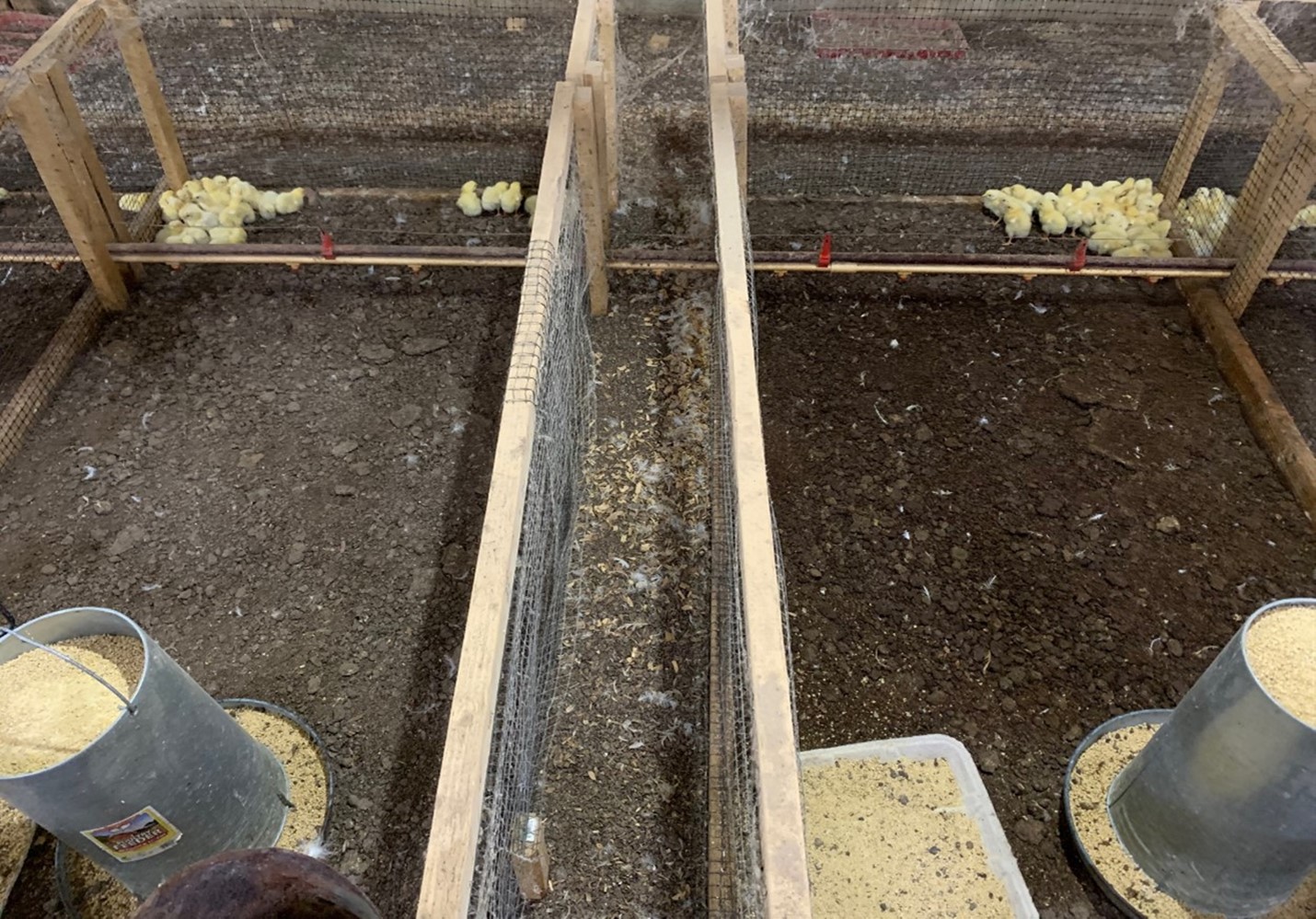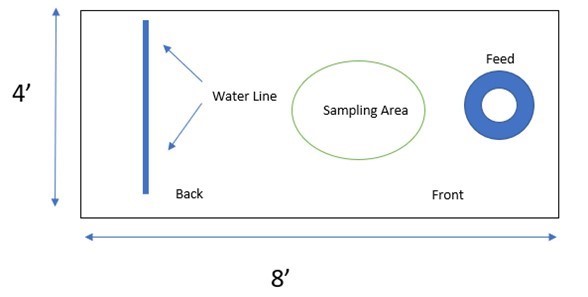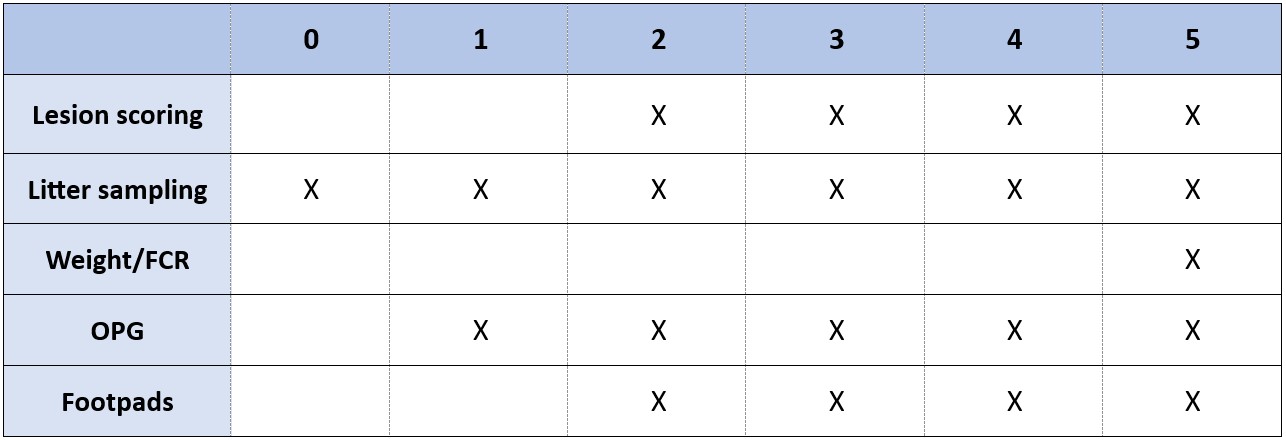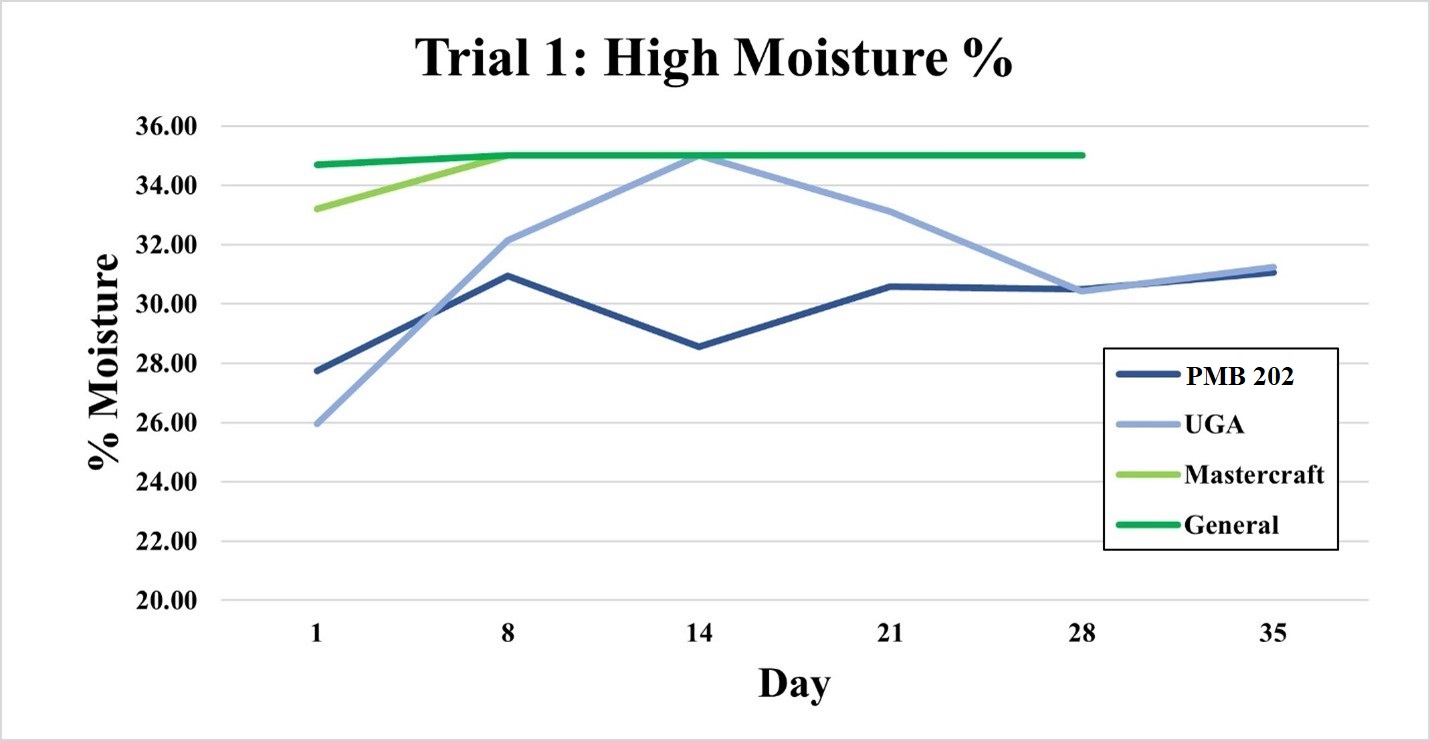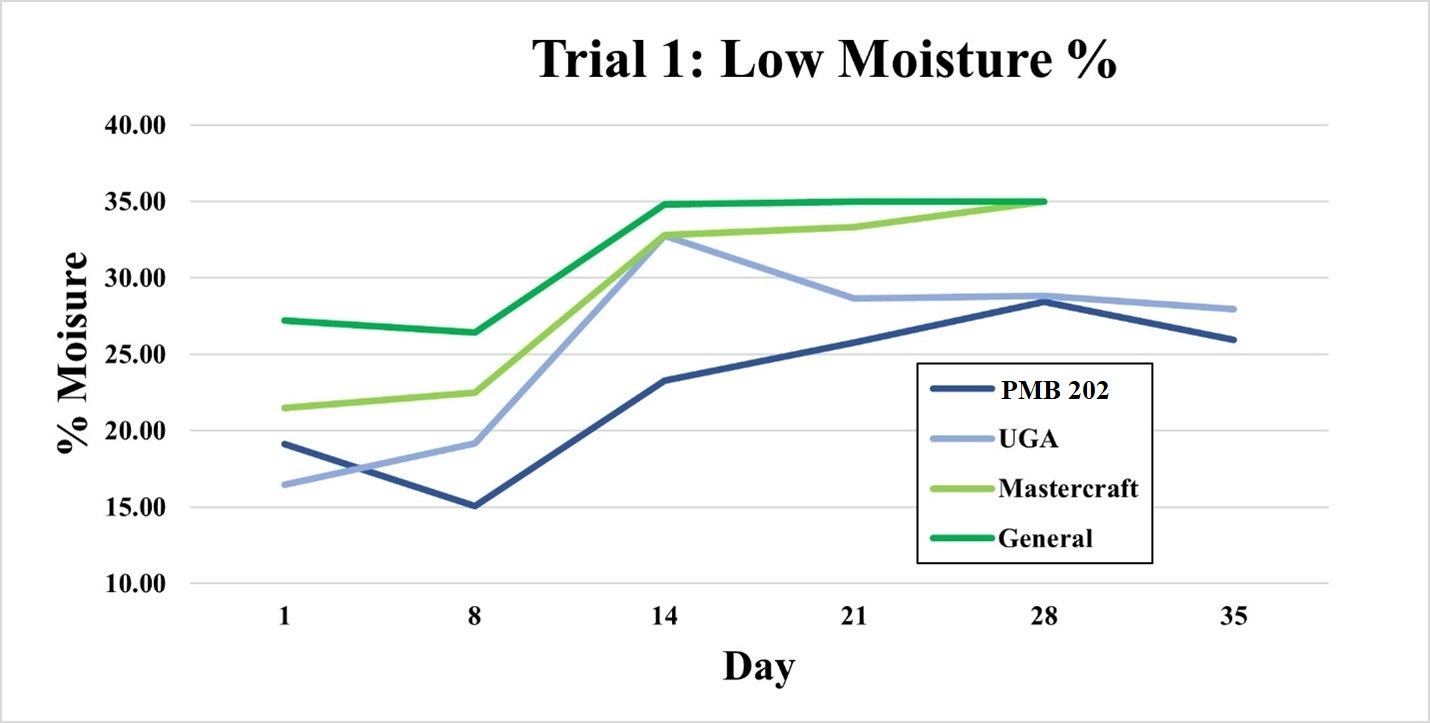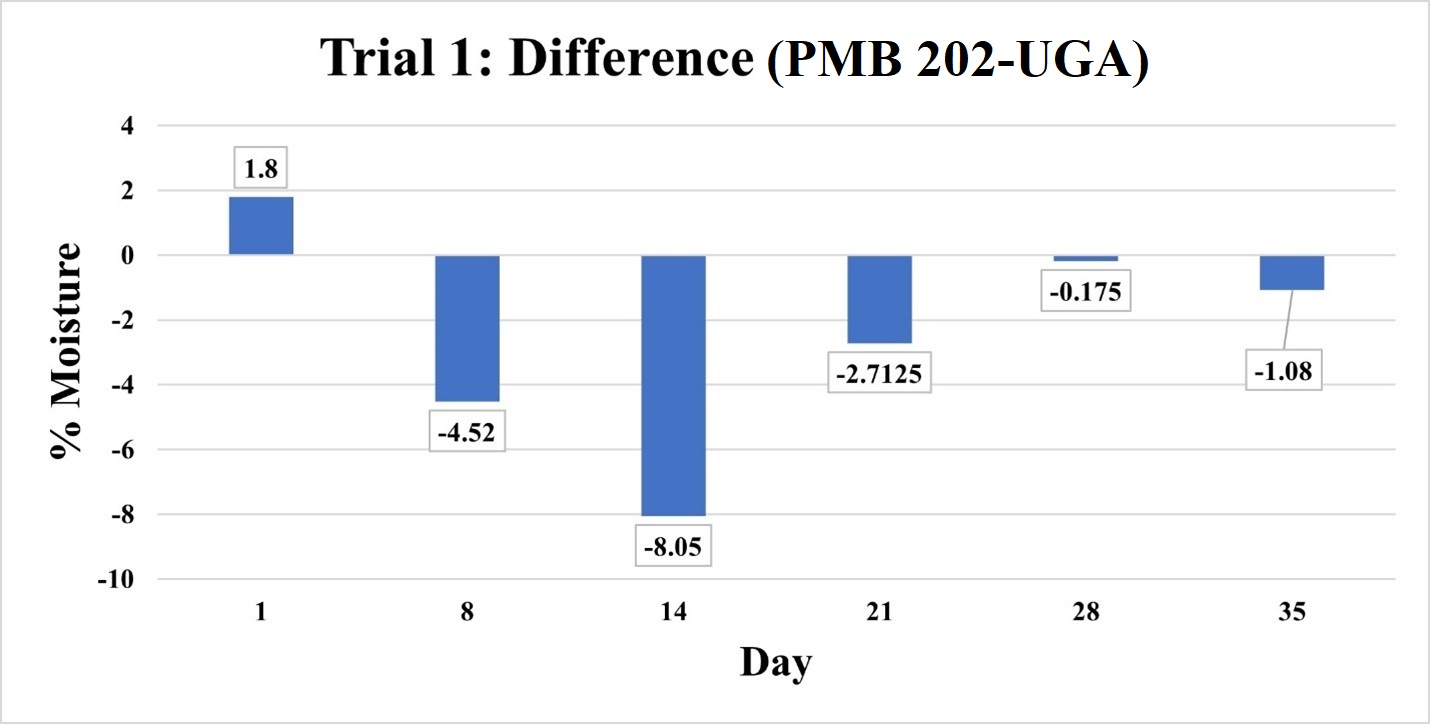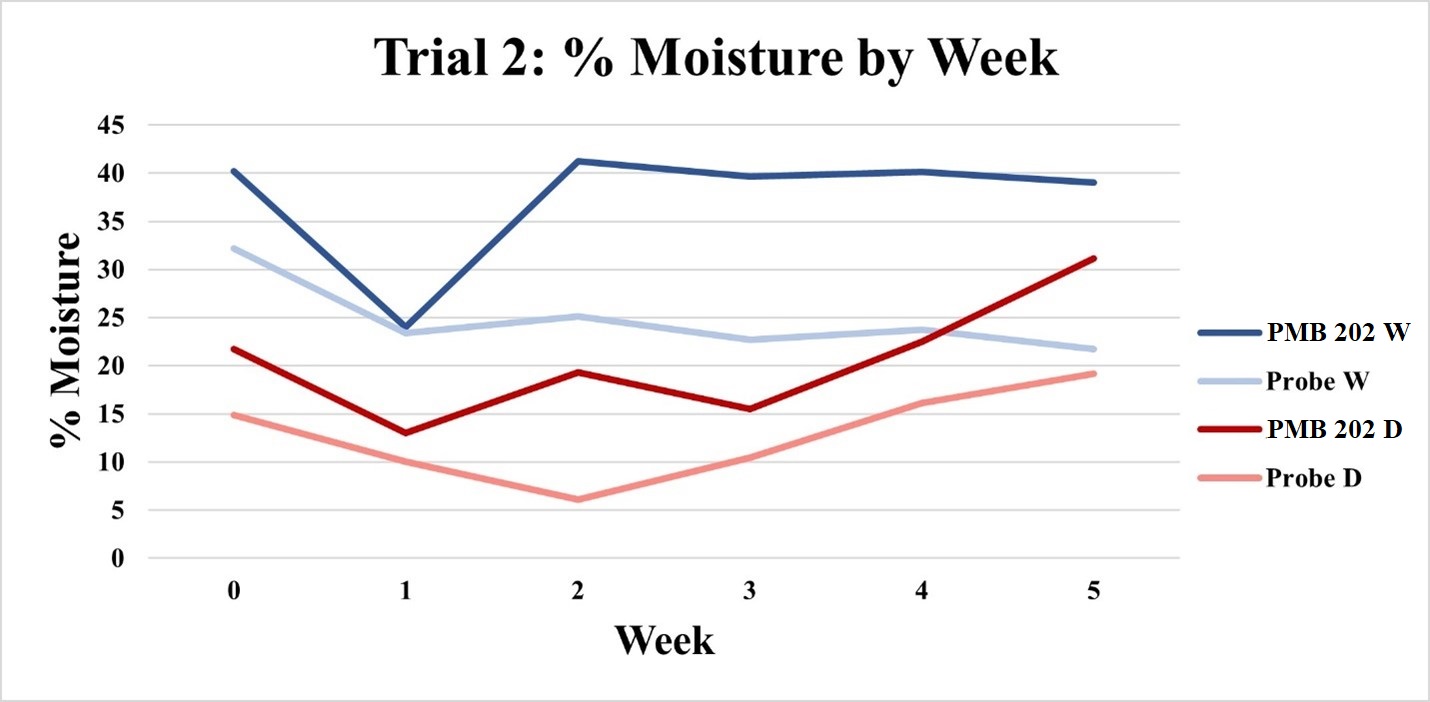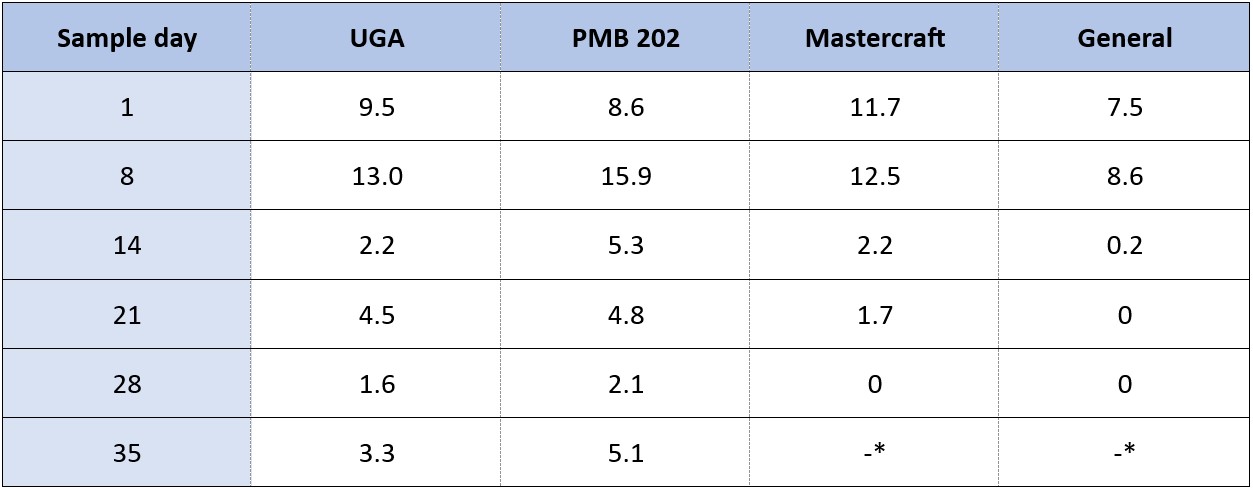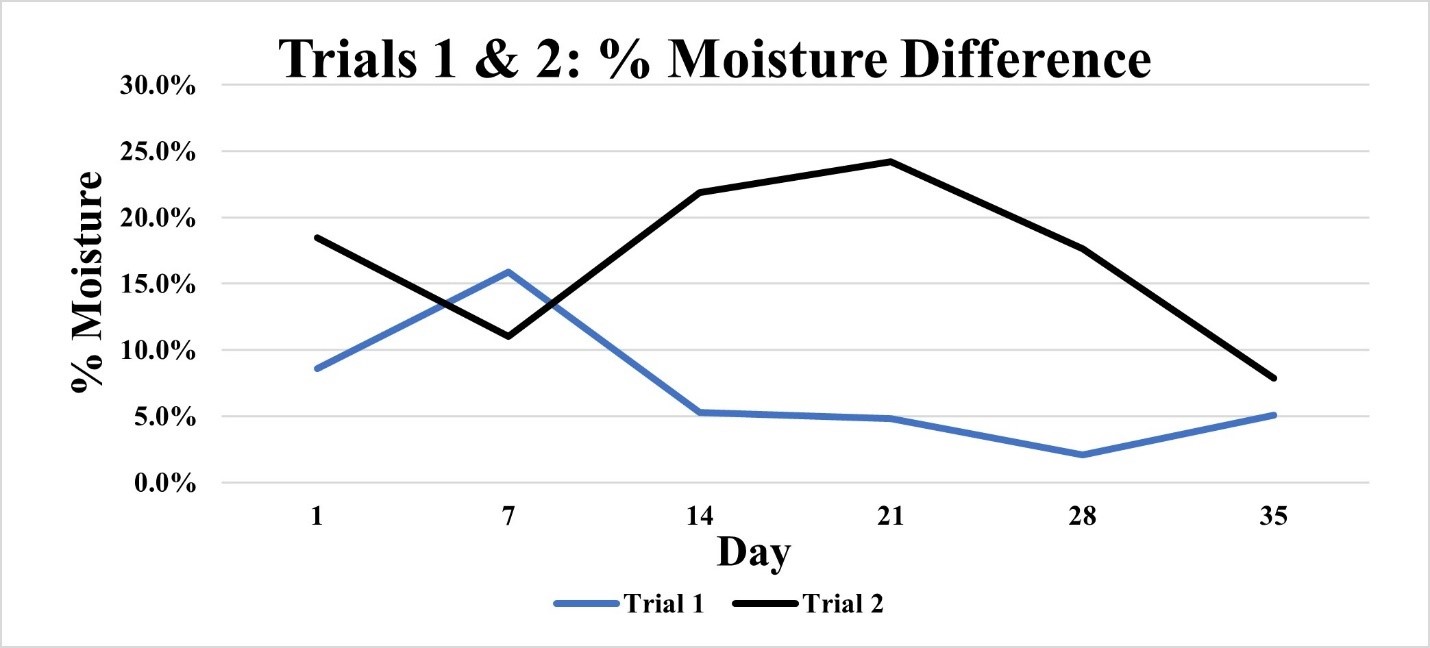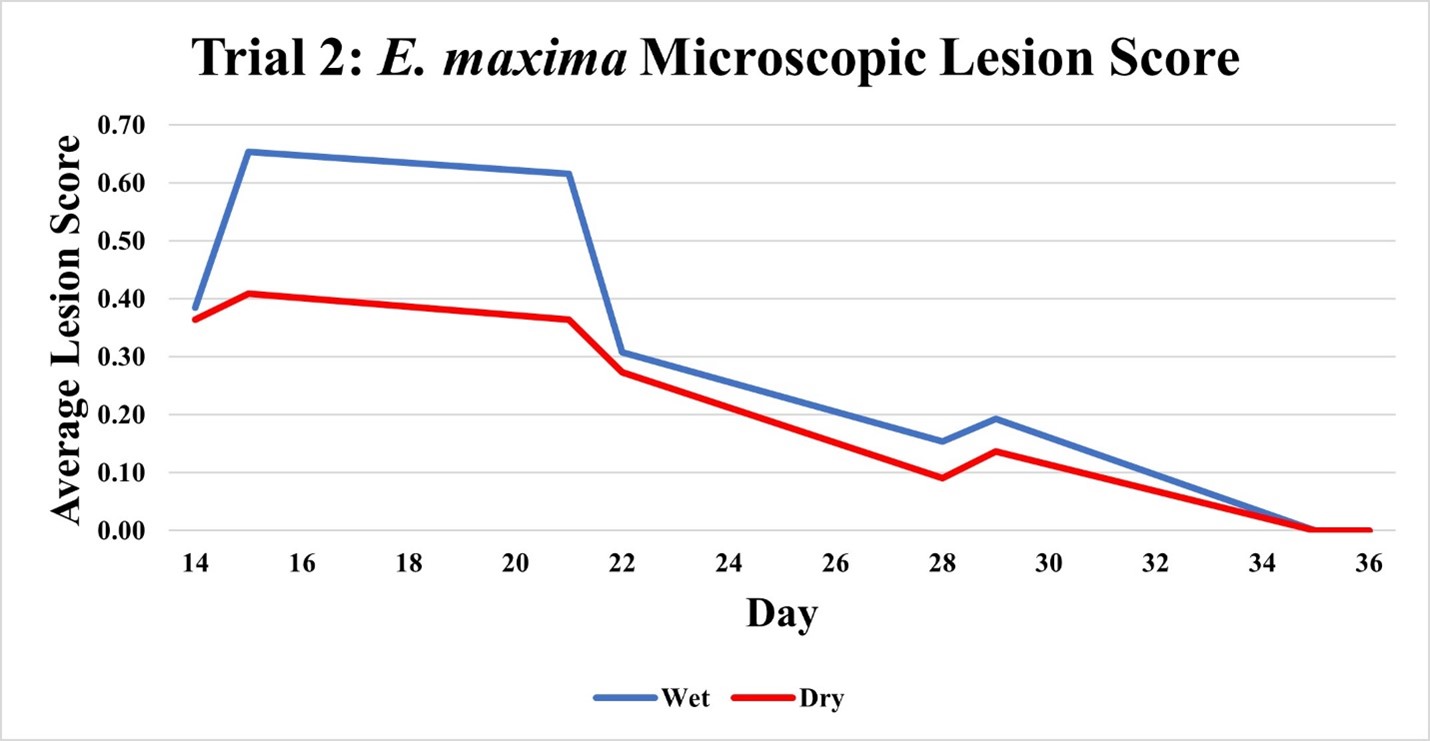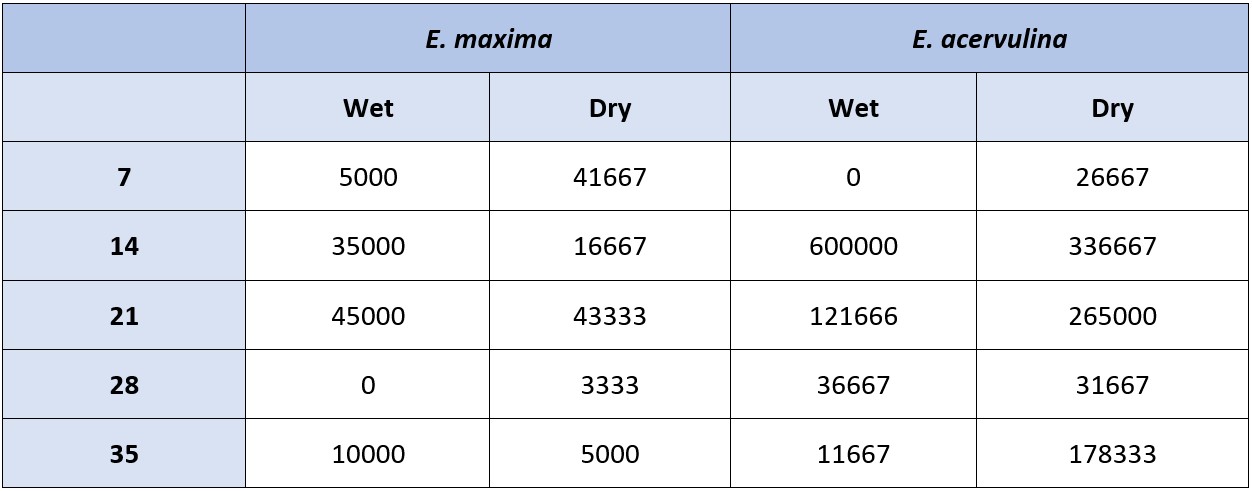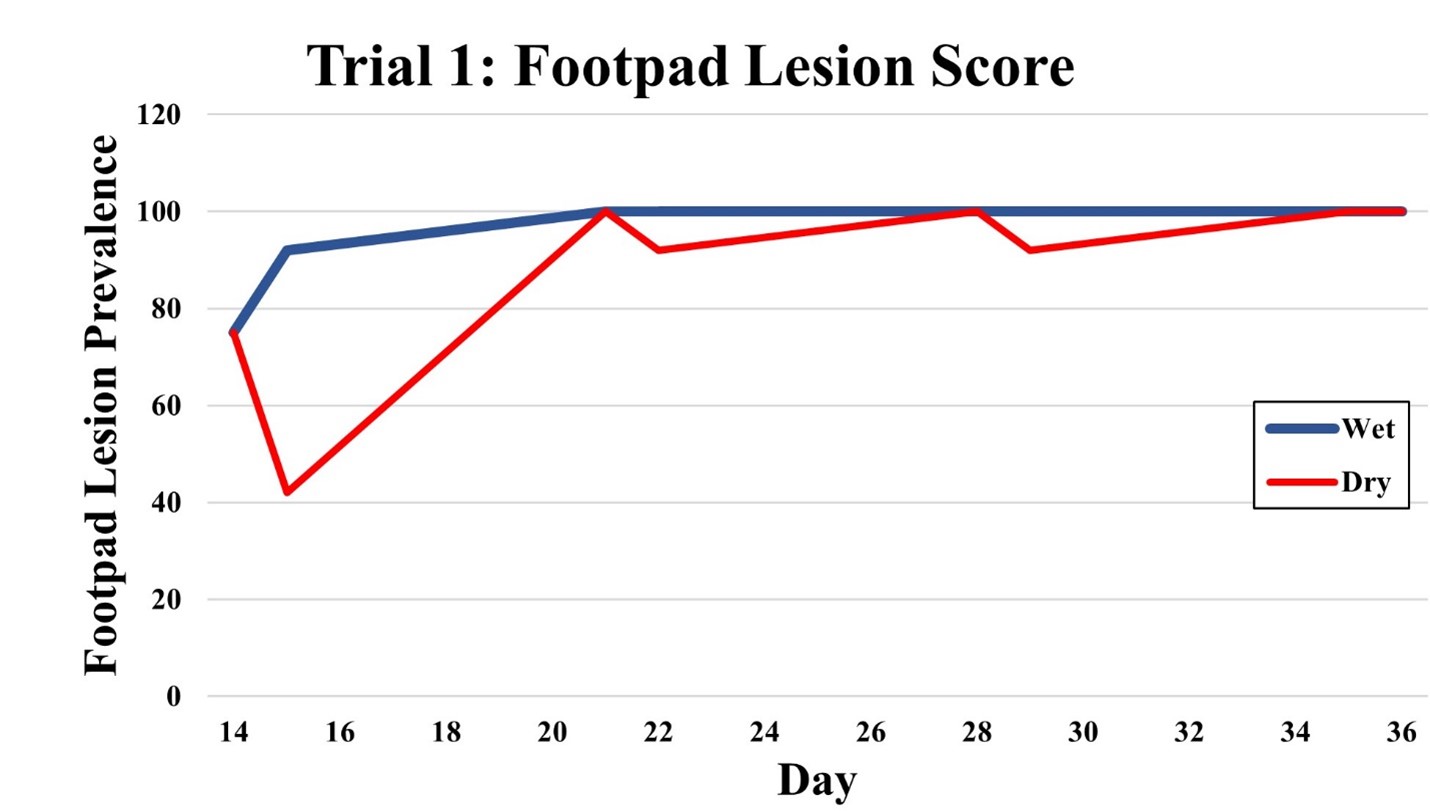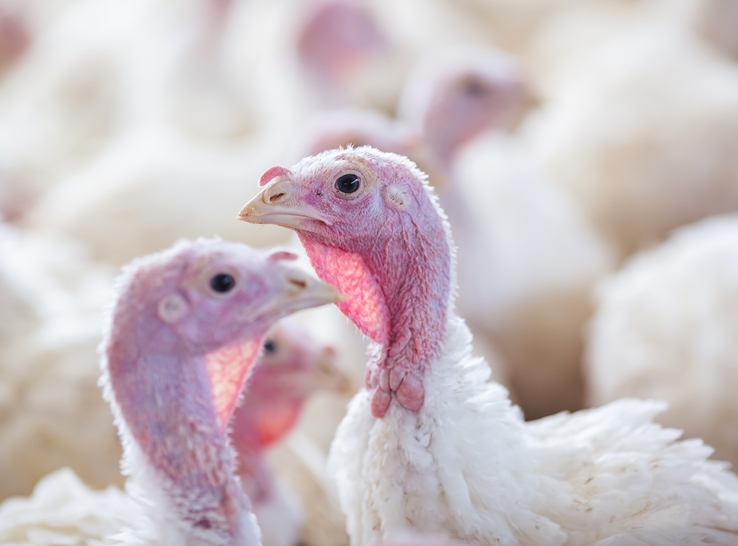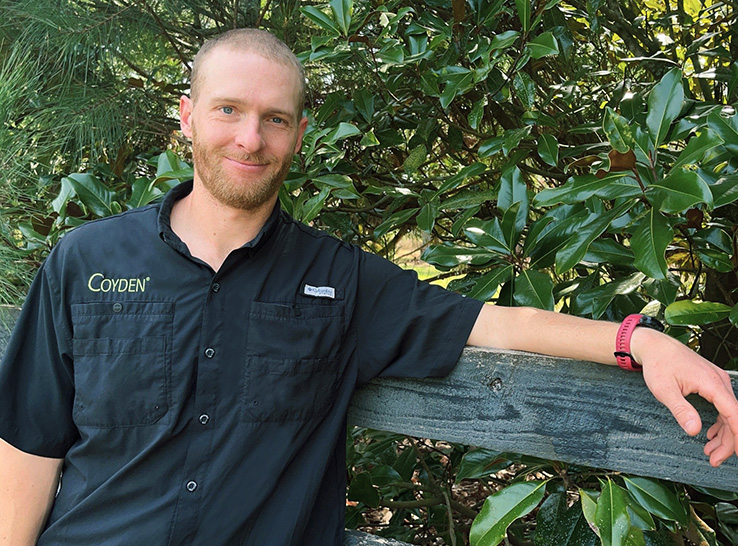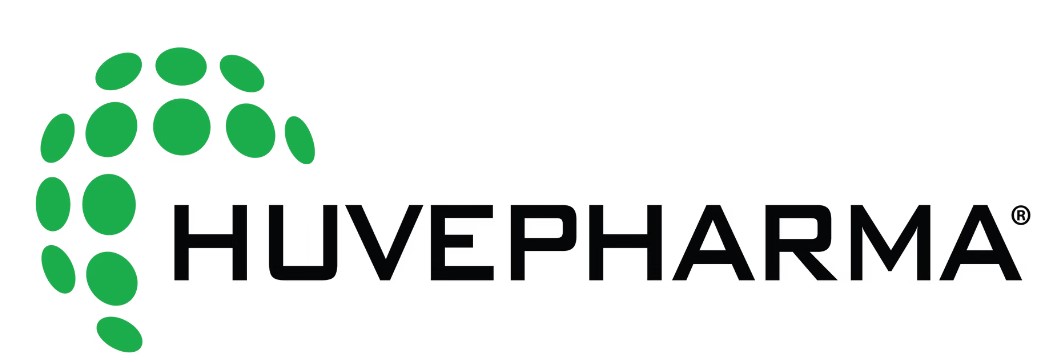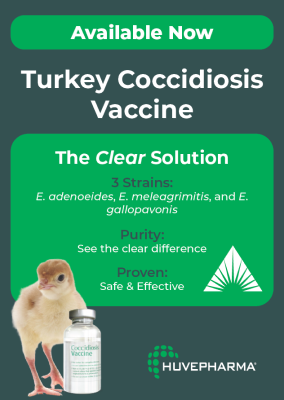By Nicholas Brown, DVM, Professional Services Veterinarian, Huvepharma, Inc.
Coccidiosis vaccination is a critical tool to mitigate economic losses for broiler producers. However, dry litter conditions and low placement densities can complicate successful vaccine replication and subsequent immunizing exposure.
Huvepharma, Inc., recently conducted a study with Poultry Research Partners, LLC, Athens, Georgia, to evaluate common methods for measuring litter moisture, as well as the effects of dry litter on vaccine cycling and zootechnical performance. Southern Poultry Feed & Research, Inc., provided the feed for the study.
Data from this two-part study revealed a consistent, on-site method for measuring litter moisture, but no significant differences between wet and dry litter treatments were seen on lesion scoring or zootechnical performance.
These results suggest that litter moisture alone may not be the most critical factor in the success of coccidiosis vaccination and immunization.
Is litter moisture a problem for vaccines?
To mitigate the negative economic impacts of coccidiosis, particularly Eimeria maxima, broiler producers are increasingly relying upon coccidiosis vaccination, with use increasing over 124% from 2015-2021.1
Successful immunization against coccidiosis relies on repeated exposure, usually after a single vaccination at the hatchery. As such, litter conditions can theoretically influence this repeated exposure due to the required exogenous stage of the coccidiosis life cycle.
Although it has been reported that wet litter increases the severity of coccidiosis,2 research on this relationship is lacking. Some in- vitro research has been conducted on oocyst sporulation rate at varying moisture levels with inconsistent results.3,4
Other possible mechanisms for this relationship include oocyst accumulation over time due to higher survival rates in wet litter as well as increased uptake of oocysts due to litter consistency or “stickiness.”
In addition, an accurate, rapid, on-site method for measuring litter moisture is not widely available. Several handheld devices utilizing the principle of electrical conductance have been used, but the variations in form and particle size of poultry litter make these devices unsuitable. Heating a small sample of litter and quantifying the moisture loss to evaporation is another common method that may produce more consistent results but requires access to a large heat source which is not readily portable.
Three study objectives
Investigators had three objectives going into this study:
- Evaluate three on-site moisture-reading devices as compared to an established laboratory method of oven-drying. The two handheld meters were the Model 057-4572-0 Pinless Moisture Meter (Mastercraft Canada, Toronto, Canada) (Mastercraft) and the GeneralTM Model MMD7NP Pinless Moisture Meter (General Tools and Instruments, Secaucus, NJ) (General). The portable, oven-drying device was the PMB 202 Moisture Analyzer (Adam Equipment, Oxford, CT) (PMB 202).
- Create an experimental model with high and low litter-moisture treatments as measured by the above methods.
- Determine if differences in litter moisture impacted coccidiosis lesion scores and zootechnical performance.
Experimental design
The experiment involved two trials:
Trial 1
Investigators vaccinated approximately 400 1-day-old Cobb 500 byproduct male chicks with one dose of Advent® coccidiosis vaccine (Huvepharma Inc.) on day 1 using a commercial spray cabinet, per the manufacturer’s recommendations. They housed all chicks in 4-foot by 8-foot floor pens with reused pine shaving litter.
The researchers then divided chicks into 12 pens with 30 birds each (1.07 square feet per bird). They designated six pens as “dry” and managed them to maintain the driest possible litter conditions without removing or adding any litter. They designated the other six pens as “moist” litter treatments, with water sprayed into the front of each pen as needed to maintain a higher moisture level. Figure 1 demonstrates the visual difference between adjacent wet and dry pens after moisture treatment.
Figure 1. Adjacent wet and dry pens after moisture treatment (pen at right designated “wet”)
Investigators sampled approximately 20 grams (0.04 pound) of litter every 7 days from each pen and tested it for moisture content. They collected each sample from the center of each pen between the feed and water as illustrated in Figure 2. In addition, they used the two handheld moisture meters to test three representative areas in the sampling area.
To evaluate oocyst cycling, the scientists randomly selected two birds per pen for lesion scoring at each time point (Table 1). They conducted lesion scores on 2 consecutive days each week (days 14-15, 21-22, 27-28 and 35-36) while adding replacement birds to each pen to maintain appropriate stocking densities, which in turn helped to maintain moisture and coccidiosis-cycling levels. They also marked the replacement birds to be excluded from future lesion scoring.
The Johnson and Reid lesion-scoring method was used for gross Eimeria acervulina with a similar 0-4 scale used for microscopic E. maxima scoring.
Figure 2. Diagram of pen setup for trials 1 and 2
Table 1: Data-collection schedule by week
Each week investigators collected fecal samples from the litter and performed oocysts counts per gram (OPG) for E. maxima and E. acervulina. They also evaluated footpad lesions based on the AviappTM lesion-scoring system (Huvepharma, Inc):
- 0 = No non-removable scabs or debris
- 1 = Lesions on the main footpad (metatarsal-phalangeal)
- 2 = Lesions on both the main footpad and the distal (inter-phalangeal) pads.
They measured feed consumption by phase and recorded pen weights at day 36 to calculate final bodyweights (BW) and feed-conversion ratios (FCR) for each treatment. In addition, they followed published animal care and use guidelines throughout the experiment. (All animals were humanely euthanized by appropriately trained personnel using AVMA-approved methods, which included cervical dislocation and carbon dioxide asphyxiation.)
Trial 2
The experimental design for Trial 2 was the same as Trial 1 except for:
- Sample size was doubled (24 pens with 30 birds each).
- OPG samples and footpad lesions were not measured.
- Coccidiosis vaccine was administered via oral gavage.
- Litter moisture was only analyzed using the PMB 202 and the ATO-MM-PMS 710 Digital Soil Moisture Meter (ATO, Diamond Bar, CA) (ATO).
- More water was added to the “moist litter” pens to achieve higher moisture in the first 2 to 3 weeks.
Pen management
The floor-pen unit in this trial was a modified 40-foot by 500-foot broiler house with solid sidewalls, and pens were arranged along a central aisle. Each pen had approximately 6 inches of reused litter on dirt floors.
From day 1 through day 5, investigators supplied feed ad libitum on a tray placed on the litter of each pen and in a 40-pound tube feeder (one per pen). They provided water ad libitum via nipple drinkers.
Investigators followed Cobb 500 house-management guidelines for lighting and temperature. They monitored and recorded building temperature daily and inspected birds daily to observe the general health status and to ensure constant feed and water supply. When a bird was culled or found dead, they recorded the date and weight (kilograms).
Feed
Southern Poultry Feed & Research provided diet formulations and feed for the trial. Birds were fed according to the following schedule:
- Day 0-14: Crumbled starter
- Day 14-28: Pelleted grower
- Day 28-36: Pelleted finisher
A 1-kilogram sample was collected and retained from each batch of feed used.
Litter-moisture measurements
Investigators collected a litter sample (50 to 100 grams) from each pen at six timepoints (Table 1) and screened it using a household-type colander to exclude large particles (> 1 cubic centimeter).
They divided samples in half, sending one portion to the University of Georgia Feed and Environmental Water Lab (UGA lab) for moisture testing and retaining the others for testing with the PMB 202 device. Approximately 20 grams of litter for each sample was tested with the device.
The handheld meters in the trial included the Mastercraft and General meters for Trial 1 and the ATO soil meter for Trial 2. Investigators tested three representative areas in the pens and averaged each measurement.
In both trials, the researchers analyzed all data using a one-way ANOVA with a 95% confidence interval. Due to inherent variability and limited sampling, OPG counts were not statistically analyzed.
Results and discussion
Objective 1: Measurement methods
Trial 1 moisture-level readings between the PMB 202 device and the UGA lab were within 5% moisture of each other except for the week-2 readings (Figures 3-5).
The week-2 difference may be attributed to some sampling delays caused by the limited availability of the UGA lab during the study period. PMB 202 device readings tended to be lower than the UGA lab. The PMB 202 device was able to measure most samples in approximately 20 minutes. The exact sampling time for the UGA lab is unknown, with results taking several days to be reported.
Figure 3: Mean moisture-level measurements in “moist” pens for Trial 1 using all methods
Figure 4: Mean moisture-level measurements in “dry” pens for Trial 1 using all methods
Figure 5: Mean difference in moisture level-readings between PMB 202 device and UGA lab in Trial 1
Readings for the handheld meters in Trial 1 ranged from 21.5% to 35% (Figures 3 & 4), which were consistently higher than the oven-drying methods.
At the higher moisture levels in Trial 1, the handheld devices recorded a maximum level of 35%, despite the oven-drying methods recording higher values in the later stages of the trial. For this reason, day-35 readings were not conducted. This limitation is likely the result of these devices being designed and calibrated for use on more solid, uniform surfaces such as drywall, concrete or wood.
Due to this limitation, the variability observed when moving the handheld devices throughout the pens, and the consistent agreement of the PMB 202 device to the UGA lab, investigators designed Trial 2 to primarily use the PMB 202 device and test a new handheld device designed for soil (ATO). This device tended to measure lower than the PMB 202 device but did roughly parallel the pattern of the PMB 202 (Figure 6) for wet and dry pens.
Figure 6: Mean moisture levels for wet (W) and dry (D) pens during Trial 2 using both methods
Objective 2: Moist versus dry treatments
In Trial 1, all litter-moisture readings using all methods recorded higher in the “moist litter” pens than the “dry litter” pens with differences ranging from 0.2 % moisture to 13% (Table 2). These results were also repeated in Trial 2 (Table 3) with differences ranging from 2.5% to 24%.
Statistical analysis performed on Trial 2 mean-moisture readings confirmed significant differences between the wet and dry groups except for the day-35 probe readings. Investigators observed larger differences between the groups (W-D) than Trial 1 (Figure 7).
Table 2. Trial 1 mean-moisture differential (wet-dry), percentage
*Day 35 handhelds (M and G) were not used.
Table 3. Mean litter-moisture readings (%) and differences between treatments from Trial 2
Figure 7. Mean difference between wet and dry litter treatments in Trial 1 and 2 using the PMB 202 device (wet minus dry)
Both trials were successful in generating consistent differences between treatments, although these differences decreased toward the end of the trial. This is likely due to the larger birds producing more moisture into the litter and the inability to remove moisture from the dry pens. After week 3, little to no moisture was added to the wet pens.
Objective 3: Coccidiosis lesion scoring
Trial 1
Except for the day-22 microscopic E. maxima scores, there were no statistically significant differences in lesion scores.
Lesion scores are graphed in Figures 8 and 9. On days 15 and 21, mean microscopic E. maxima lesions were numerically higher for the high litter-moisture group. Mean gross E. acervulina lesion score was also higher at day 15.
This 2- to 3-week period was of the most interest to the investigators because it corresponded to the time in which a greater moisture differential could be generated between treatments as well as the critical “early cycling” period that has been associated with immunity development.5
Figure 8: Mean gross E. acervulina scores for both treatments in Trial 1
Figure 9: Mean microscopic E. maxima scores for both treatments in Trial 1
Trial 2
As in Trial 1, investigators did not see any statistically significant differences in lesion scores except for the day-15 gross E. acervulina lesion scores (Figures 10 and 11). They also found E. acervulina scores at day 15 and microscopic E. maxima scores at days 15 and 21 to be numerically higher, just as they were in Trial 1, but not statistically significant.
The lack of statistical relevance suggests that more sampling power or further increasing the magnitude of the independent variable (litter-moisture level) may be needed.
Previous studies have estimated the maximum moisture-holding capacity to be 71% to 74%.6 However, in Trial 2, investigators felt that a sufficient difference in litter moisture was generated without causing significant management problems.
Another method for increasing the magnitude of this variable would be to devise a method to selectively dry litter in the dry treatments, as well as adding moisture to the wet pens. This possibility requires further study.
Figure 10: Mean microscopic E. acervulina scores for both treatments in Trial 2
Figure 11: Mean microscopic E. maxima scores for both treatments in Trial 2
The coccidiosis-challenge level is also a factor to consider. As seen in the lesion scoring figures, mean lesion scores were mainly between 0 and 1 out of 4. This indicates that the challenge level was relatively low. Increasing the challenge level in future trials may result in statistical differences.
However, because the aim of this study was to evaluate moisture level on vaccine cycling, increasing the challenge level beyond the levels typically seen in the field for vaccinated birds would be tangential to this objective.
Finally, the use of multiple litter types should be evaluated. This experiment used reused pine shavings that were 5-plus years old with very few new shavings mixed in. Different litter types (peanut hulls, rice hulls), as well as ages of litter, may yield different results.
Zootechnical performance
No significant differences in performance parameters were observed between wet and dry litter treatments in either trial (Tables 4 and 5).
Table 4: Performance of wet and dry pen treatments in Trial 1 (pounds)
Table 5: Performance of wet and dry pen treatments in Trial 2 (pounds)
OPG measurements
OPG counts in Trial 1 for E. maxima and E. acervulina are shown in Table 6. Although counts for both peaked at higher numbers (45,000 and 600,000, respectively) for the high-moisture pens, weekly counts were highly variable and of low analytical value.
Table 6: OPG for E. maxima by day for wet and dry treatments in Trial 1
Footpad lesion scoring
Footpad scores showed no significant differences in average score on any day in Trial 1. Prevalence of footpad scores ranged from 42% to 100% throughout the trial (Figure 12).
Figure 12: Footpad lesion-score prevalence throughout Trial 1
Conclusions and applications
Investigators concluded the following from the two trials:
- The use of the PMB 202 device correlated well with a known standard laboratory oven-drying method. This could be used as a more portable, rapid (< 30 mins.) method for measuring litter moisture either in the lab or on the farm.
- The handheld meters, particularly those not designed for soil, produce inconsistent results for measuring poultry-litter moisture. These devices do not provide reliable results for managing litter moisture.
- Adding moisture to select floor pens successfully generated an experimental model with significantly different moisture levels in reused pine shaving litter.
- Pens with differing levels of litter moisture could not produce consistent significant differences in lesion scores for either microscopic maxima or gross E. acervulina, nor did they present consistent patterns in OPG counts.
- Differing levels of litter moisture resulted in no differences in measured performance parameters (FCR, weight, etc.) or footpad lesion scores in either trial.
- While litter moisture has an impact on coccidiosis cycling, elucidating this impact and applying it to a vaccination program requires further study.
References
1 RAI Market Tracker 2022 Rennier Associates, Inc.
2 Waldenstedt L, Elwinger K, Lundén A, Thebo P, Uggla A. Sporulation of Eimeria maxima oocysts in litter with different moisture contents. Poult Sci. 2001;80(10):1412–1415.
3 Graat EA, Henken AM, Ploeger HW, Noordhuizen JP, Vertommen MH. Rate and course of sporulation of oocysts of Eimeria acervulina under different environmental conditions. Parasitol. 1994 June;108(5):497-502.
4 Waldenstedt L, Elwinger K, Lundén A, Thebo P, Uggla A. Sporulation of Eimeria maxima oocysts in litter with different moisture contents.
5 Williams RB, Andrews SJ. The origins and biological significance of the coccidial lesions that occur in chickens vaccinated with a live attenuated anticoccidial vaccine. Avian Pathol. 2001;30(3):215-220.
6 Dunlop MW, Blackall PJ, Stuetz RM. Water addition, evaporation and water holding capacity of poultry litter. Sci Total Environ. 2015;538:979-985.
Content on Modern Poultry’s Industry Insights pages is provided and/or commissioned by our sponsors, who assume full responsibility for its accuracy and compliance.



